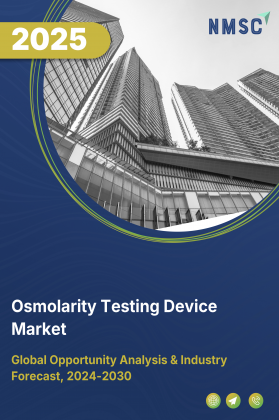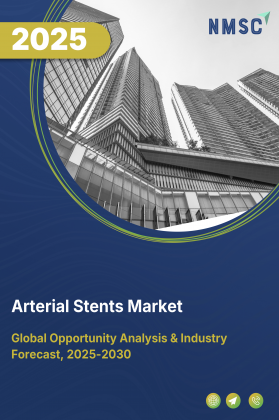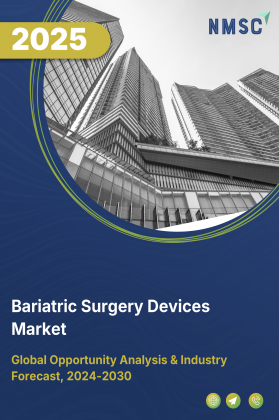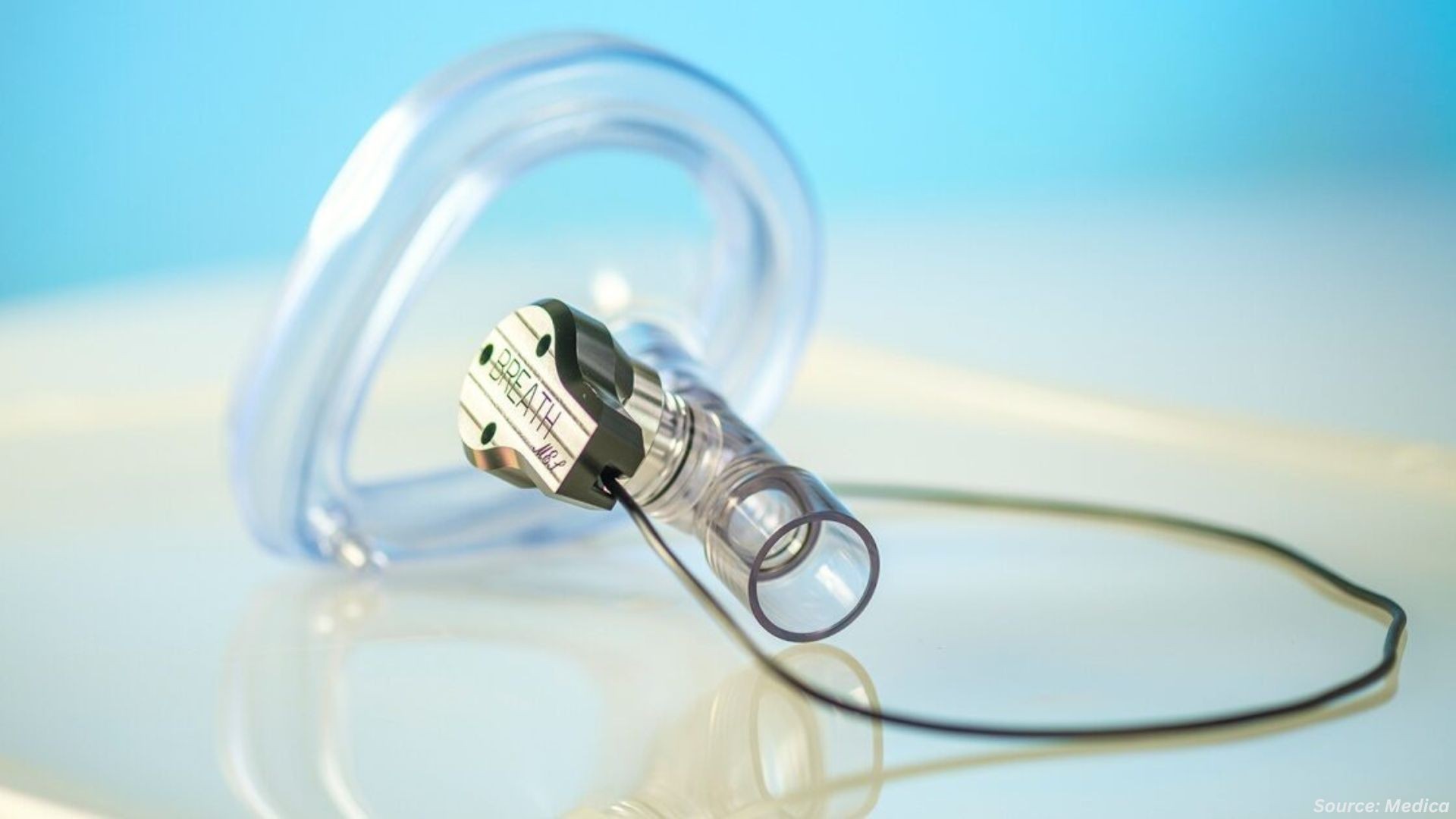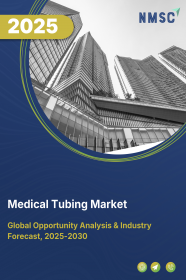
Medical Tubing Market by Material, (Thermoplastics, Elastomers, Specialty Polymers, Other Materials), by Structure/construction, (Lumen-based, Multi-layer, Reinforced, Specialty Structures, Other Structures), by Application, (Bulk Disposable Tubing, Catheters and Cannulas, Drug Delivery Systems, Biopharma And Lab Equipment, Surgical and Respiratory Support, Other Medical Devices) – Global Opportunity Analysis and Industry Forecast 2025-2030
Medical Tubing Market Overview
The global Medical Tubing Market size was valued at USD 11.68 billion in 2024 and is predicted to reach USD 12.68 billion by the end of 2025. The industry is predicted to reach USD 18.86 billion by 2030 with a CAGR of 8.3% from 2025-2030.
The medical tubing market is experiencing steady growth driven by increasing demand for advanced healthcare solutions, including the widespread use of minimally invasive surgeries, the growing geriatric population, and the rising prevalence of chronic diseases. These trends call for high-performance tubing with precise functionality for procedures such as endoscopy, dialysis, and drug delivery.
Innovations in material science and manufacturing techniques, such as new polymer developments and advanced extrusion processes, are expanding application possibilities and improving product performance.
However, the market faces challenges due to mounting healthcare cost pressures, which can impact pricing and innovation. Despite this, the integration of smart sensor technologies into tubing systems offers promising future opportunities by enabling real-time monitoring and enhancing treatment accuracy across various medical applications.
Increasing Adoption of Minimally Invasive Surgeries Fuels the Market Growth
The increasing preference for minimally invasive surgeries (MIS) is significantly driving the demand for sophisticated medical tubing. These procedures offer numerous benefits, including smaller incisions, reduced scarring, shorter hospital stays, and faster recovery times, making them increasingly popular among patients and healthcare professionals alike. This trend necessitates the development of medical-grade tubing with precise dimensions, flexibility, and functionality to navigate complex anatomical pathways and deliver or extract fluids and devices effectively.
For instance, advancements in extrusion technologies allow for the creation of multi-lumen and co-extruded tubing crucial for complex MIS catheters. The need for specialized tubing in areas like endoscopy, laparoscopy, and interventional cardiology directly contributes to the market growth potential and expands the medical-grade tubing market size.
Growing Geriatric Population and Chronic Disease Prevalence Propels the Market
The global rise in the aging population and the increasing prevalence of chronic diseases are significant factors propelling the industry forward. As people age, they become more susceptible to various chronic conditions such as cardiovascular diseases, diabetes, and kidney disorders, often requiring long-term medical interventions and therapies. These conditions frequently rely on medical-grade tubing for fluid management, drug delivery, and dialysis, among other applications.
For example, the increasing incidence of renal failure directly correlates with a higher demand for dialysis tubing. This demographic shift and the associated healthcare needs represent a substantial and sustained market driver for the medical-grade tubing industry.
Advancements in Material Science and Manufacturing Technologies Boosts the Market
Continuous advancements in material science and manufacturing technologies are critical drivers of the medical tubing market growth. The development of new polymers, such as advanced grades of thermoplastic elastomers (TPEs) designed for biopharmaceutical applications, and materials like ultra-polyimide, allows for the creation of tubing with enhanced properties like improved biocompatibility, chemical resistance, flexibility, and durability.
Furthermore, advancements in extrusion processes, including micro-extrusion and co-extrusion, enable the production of complex tubing designs with tighter tolerances. Techniques like femtosecond laser micro-drilling are also being explored for creating precise features in polymer tubing. These technological leaps expand the range of applications for medical-grade tubing and contribute to the overall market growth.
Rising Healthcare Costs Restrains the Growth of the Market
The increasing pressure to contain healthcare costs globally represents another significant restraint for the industry expansion. Healthcare providers and payers are constantly seeking ways to reduce expenses, which can lead to downward pressure on the pricing of medical devices and components, including tubing.
This cost sensitivity can challenge manufacturers to maintain profitability while investing in innovation and adhering to stringent quality standards. The balance between providing high-quality medical-grade tubing and meeting the demands for cost-effectiveness remains a crucial challenge for the industry.
Integration of Smart Sensor Technology in Medical Tubing Creates Future Market Opportunities
The integration of smart sensor technology in medical tubing, enabling real-time monitoring of patient conditions, is a transformative advancement poised to create significant future market growth opportunities by enhancing patient safety and treatment precision in applications like catheters, IV lines, and respiratory tubing. This technology allows tubing to collect and transmit data on parameters such as fluid flow, pressure, or infection indicators, addressing the rising demand for minimally invasive procedures and personalized healthcare.
A notable recent development is Nordson Corporation’s launch of Pharma+ Tubing Retainers in December 2023, designed for high-pressure biopharmaceutical and medical applications, incorporating sensor-enabled fluid transfer technology to improve monitoring and reduce complications. This advancement positions smart tubing as a key driver for the medical tubing market expansion.
Market Segmentation and Scope of Study
The medical tubing market report is segmented on the basis of product type, material, structure, application, end user, and regions. On the basis of product type, the market is divided into silicone, polyolefins, polyimide, polyvinyl chloride, polycarbonates, fluoropolymers, and others. Fluoropolymers are further segmented into polytetrafluoroethylene (PTFE) and fluorinated ethylene propylene (FEP). On the basis of material, the market is categorized into plastics, rubbers, and specialty polymers. By structure, the market is segmented into single-lumen, co-extruded, multi-lumen, tapered or bump tubing, and braided tubing. On the basis of application, the market is divided into bulk disposable tubing, catheters and cannulas, drug delivery systems, biopharmaceutical laboratory equipment, and others. By end user, the market is segmented into hospitals and clinics, medical device manufacturers, ambulatory surgical centers (ASCs), and others. Regional breakdown and analysis of each of the aforesaid segments includes regions comprising North America, Europe, Asia-Pacific, and RoW.
Geographical Analysis
North America remains a mature and technologically advanced market for medical tubing, supported by a robust healthcare infrastructure and a strong emphasis on innovation. This is evident in collaborations and product launches such as Nordson Corporation’s Pharma+ Tubing Retainers introduced in December 2023, which feature sensor-enabled fluid transfer technology for biopharmaceutical applications.
Further reinforcing innovation, the U.S. National Institutes of Health invested USD 50 million in smart medical technologies in 2024 to enhance device performance, including advanced tubing systems.
However, ongoing trade tensions stemming from the U.S.-China trade war have led to a 15% increase in raw material costs, as reported by the U.S. Department of Commerce, disrupting medical device supply chains.
In addition, China's 2024 export restrictions on seven critical rare earth elements, according to the U.S. Geological Survey, pose a risk to the availability of high-tech materials essential for medical tubing production, potentially leading to supply shortages.
Europe's medical tubing market is shaped by strict regulatory compliance, particularly under the EU Medical Device Regulation (MDR), enforced by the European Commission. While this framework has raised compliance costs by 20%, it ensures superior product quality and patient safety. The region's manufacturers are also responding to the European Union's 2024 accusations against China over unfair trade practices in medical device procurement, as highlighted by the European Trade Commission.
In response, companies like Freudenberg Medical have expanded operations, such as opening new facilities in Ireland in November 2024, to meet growing demand for advanced tubing solutions. While these trade and regulatory developments foster innovation, they also present cost management challenges for medical tubing producers across Europe.
Asia-Pacific, led by India and China, is experiencing rapid expansion in the market. In India, medical device imports rose by 12% in 2024, according to the Ministry of Commerce and Industry, reflecting heightened demand for healthcare equipment. The National Medical Devices Policy 2023 further aims to enhance domestic production by 30 percent by 2030, aiming to reduce dependence on imports.
In China, the healthcare sector's continued growth, driven by public hospitals accounting for 80% of medical device procurement, as reported by the National Health Commission, supports a thriving tubing market. This is further bolstered by a 7.3% increase in medical device exports, reaching USD 48.75 billion in 2024, according to the China Chamber of Commerce, underscoring the region’s growing global influence.
Latin America and the Middle East represent emerging markets for medical tubing, influenced by varying healthcare infrastructure and economic conditions. While limited access to advanced technologies poses challenges, the global trend toward minimally invasive procedures and single-use medical devices is driving regional demand.
According to the World Health Organization, global medical device demand rose by 25%, signaling strong market potential. Latin America recorded a 14.6% increase in medical device exports, reaching USD 3.96 billion in 2024, while the Middle East saw a 15.6% rise to USD 1.94 billion, based on China’s trade data. These developments highlight growing opportunities for medical tubing manufacturers, despite existing infrastructural limitations.
Strategic Innovations Adopted by Key Players
Key players in the medical tubing industry are strategically focusing on several areas to maintain and grow their market share and leverage the significant growth potential. A prominent strategy is capacity expansion in emerging markets, exemplified by Lubrizol and Polyhose's recent MoU to increase their medical-grade tubing manufacturing capabilities in Chennai, India. This move directly addresses the rising demand in the Asia-Pacific region and signifies a push for a larger piece of the global market size.
Another key development is strategic acquisitions aimed at strengthening product portfolios and expanding expertise, as seen with MDI's acquisition of two medical-grade tubing and extrusion companies and Medical Manufacturing Technologies (MMT)'s purchase of GenX Medical.
Furthermore, companies are actively engaged in new product development and launches, focusing on advanced materials like Freudenberg Medical's HelixFlex TPE tubing for bioprocessing applications and Confluent Medical Technologies' ultra-polyimide, reflecting a market trend towards higher performance and specialized applications.
Collaborations and partnerships are also crucial, with examples like US Extruders partnering with Poba Medical and Compounding Solutions and Jabil collaborating with MIS to enhance catheter design. These strategies help navigate the challenges of stringent regulatory requirements and increasing cost pressures within the healthcare landscape, while capitalizing on opportunities such as the growing demand for minimally invasive devices and single-use medical devices.
Key Benefits
-
The report provides quantitative analysis and estimations of the medical tubing market from 2025 to 2030, which assists in identifying the prevailing market opportunities.
-
The study comprises a deep-dive analysis of the current and future medical tubing market trends to depict prevalent investment pockets in the market.
-
Information related to key drivers, restraints, and opportunities and their impact on the medical tubing market is provided in the report.
-
Competitive analysis of the players, along with their market share is provided in the report.
-
SWOT analysis and Porters Five Forces model is elaborated in the study.
-
Value chain analysis in the market study provides a clear picture of roles of stakeholders.
Medical Tubing Market Key Segments
By Material
-
Thermoplastics
-
Polyolefins (pe Pp)
-
Pvc
-
Polyamide (nylon)
-
Polycarbonate (pc)
-
Tpu
-
Fluoropolymers (ptfe Fep Pvdf)
-
-
Elastomers
-
Silicone
-
Tpe
-
Epdm/latex
-
-
Specialty Polymers
-
Bioabsorbables (pla Pga)
-
Eva
-
Radiopaque Compounds
-
-
Other Materials
-
Coated Fabrics
-
Polymer Composites
-
By Structure/construction
-
Lumen-based
-
Single-lumen
-
Multi-lumen
-
-
Multi-layer
-
Reinforced
-
Specialty Structures
-
Other Structures
By Application
-
Bulk Disposable Tubing
-
Catheters And Cannulas
-
Drug Delivery Systems
-
Biopharma And Lab Equipment
-
Surgical And Respiratory Support
-
Other Medical Devices
By End-user
-
Hospitals And Clinics
-
Ambulatory Care Centers
-
Home Healthcare
-
Diagnostic And Research Labs
-
Medical Device Oems
-
Pharma/biotech Manufacturers
By Region
-
North America
-
The U.S.
-
Canada
-
Mexico
-
-
Europe
-
The UK
-
Germany
-
France
-
Italy
-
Spain
-
Denmark
-
Netherlands
-
Finland
-
Sweden
-
Norway
-
Russia
-
Rest of Europe
-
-
Asia-Pacific
-
China
-
Japan
-
India
-
South Korea
-
Australia
-
Indonesia
-
Singapore
-
Taiwan
-
Thailand
-
Rest of Asia-Pacific
-
-
RoW
-
Latin America
-
Middle East
-
Africa
-
Key Players
-
Saint-GobainnPerformance Plastics
-
Freudenberg Medical
-
W. L. Gore and Associates
-
The Lubrizol Corporation
-
Nordson Corporation
-
Zeus Industrial Products, Inc.
-
Spectrum Plastics Group
-
Tekni-Plex, Inc.
-
Teknor Apex
-
Raumedic AG
-
Optinova
-
MicroLumen, Inc.
-
Putnam Plastics Corporation
-
Trelleborg AB (Trelleborg Medical)
-
ATAG SpA
-
MDC Industries
-
Parker Hannifin
-
Polyzen, Inc.
-
A.P. Extrusion
-
B. Braun
REPORT SCOPE AND SEGMENTATION:
|
Parameters |
Details |
|
Market Size in 2024 |
USD 11.68 Billion |
|
Revenue Forecast in 2030 |
USD 18.86 Billion |
|
Growth Rate |
CAGR of 8.3% from 2025 to 2030 |
|
Analysis Period |
2024–2030 |
|
Base Year Considered |
2024 |
|
Forecast Period |
2025–2030 |
|
Market Size Estimation |
Billion (USD) |
|
Growth Factors |
|
|
Countries Covered |
28 |
|
Companies Profiled |
20 |
|
Market Share |
Available for 10 companies |
|
Customization Scope |
Free customization (equivalent to up to 80 working hours of analysts) after purchase. Addition or alteration to country, regional, and segment scope. |
|
Pricing and Purchase Options |
Avail customized purchase options to meet your exact research needs. |

















 Speak to Our Analyst
Speak to Our Analyst



